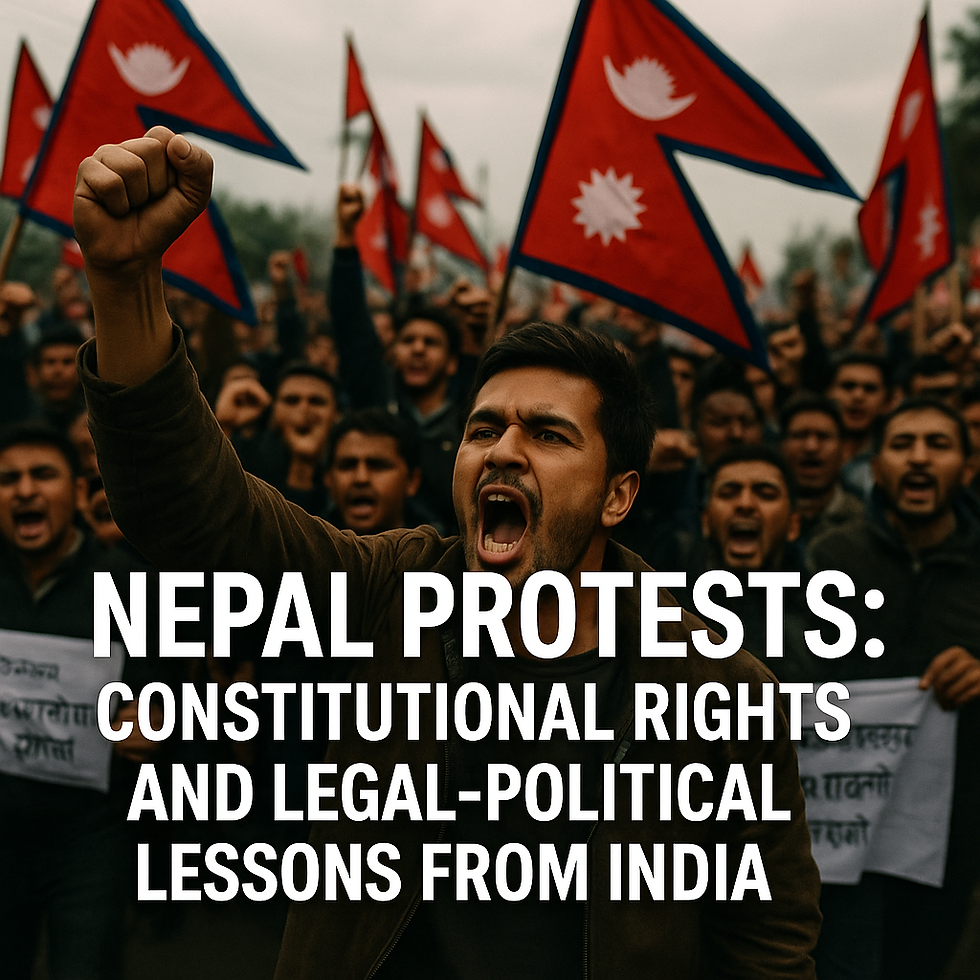Nepal Protests: Constitutional Rights and Legal-Political Lessons from India
- Amit Tiwari

- Sep 12
- 4 min read

Nepal has entered a volatile phase. Since 8 September 2025, large demonstrations over the government’s social-media policy turned violent in Kathmandu; police firing reportedly left multiple people dead and many injured, and curfews were imposed. These events throw the legal boundaries of protest into sharp focus. Comparing Nepal’s Constitution with India’s framework helps clarify where free assembly ends and state regulation begins.
Constitutional Right to Protest in Nepal
Constitution of Nepal, 2015 :
Article 17(2)(a): freedom of opinion and expression.
Article 17(2)(b): freedom to assemble peaceably and without arms.
Article 17(3): permits “reasonable restrictions” by law in the interests of sovereignty, security, public order, decency/morality, and harmonious relations, among others.
These guarantees align with India’s Constitution:
Article 19(1)(a): freedom of speech and expression.
Article 19(1)(b): right to assemble peaceably and without arms.
Articles 19(2) & 19(3): allow “reasonable restrictions” (e.g., sovereignty, public order, decency).
International law touchstone: ICCPR Article 21 protects peaceful assembly; any restriction must be lawful, necessary and proportionate to a legitimate aim. UN Human Rights Committee General Comment 37 (2020) elaborates these tests.
India’s Judicial Guidance (For Comparative Use in Nepal)
Indian courts have repeatedly balanced dissent with public order:
Shaheen Bagh case — Amit Sahni v. Commissioner of Police (2020)Supreme Court held that while the right to protest is protected, occupying public ways indefinitely is impermissible; protests must be regulated to avoid disproportionate disruption
Jantar Mantar case — Mazdoor Kisan Shakti Sangathan v. Union of India (2018)Supreme Court affirmed that citizens have a right to peaceful protest subject to reasonable regulation; blanket denials and excessive restrictions are suspect.
Early cornerstone — Himat Lal Shah v. Commissioner of Police, Ahmedabad (1973)
The Court recognized that the state may regulate assemblies on streets but cannot prohibit them altogether; permission systems must be reasonable and not a covert ban.
Police action scrutiny — In Re: Ramlila Maidan Incident (2012)
The Court underscored proportionality when dispersing assemblies and examined misuse of Section 144/force in breaking up a peaceful gathering at night.
Why it matters for Nepal: Nepal’s Article 17 uses the same logic as India’s Article 19. Courts ask: Is the restriction lawful, for a legitimate aim, necessary, and proportionate? ICCPR Article 21 and General Comment 37 provide an identical yardstick.
Government Measures in Nepal: Legal Tests to Apply
Recent reports mention curfews, arrests/detentions, and restrictions on media/platforms. Under Article 17(3) and ICCPR Art. 21, such actions must be:
Prescribed by law (clear legal basis),
For a legitimate aim (e.g., public order),
Necessary (no less-restrictive alternative available), and
Proportionate (narrowly tailored; time-bound; minimal collateral impact).
The more sweeping or prolonged the measure (e.g., blanket platform bans or broad curfews), the heavier the justification the state must offer under these standards. This is the same proportionality scrutiny Indian courts apply.
What India’s Recent Practice Shows (Helpful Signals for Nepal)
Permission & place regulation is allowed, not total bans. Courts have upheld requiring prior permission and venue management, but strike down blanket prohibitions or indefinite occupations.
Current Bombay High Court signals (2025): In the Maratha quota agitation, the Bombay High Court directed that protests without valid permission at Azad Maidan be vacated and emphasized adherence to prior orders. These aren’t anti-protest; they enforce reasonable regulation for public order.
The Nepal protests illuminate a universal constitutional dilemma: how to safeguard the right to dissent while upholding public order and other fundamental rights. On paper, both Nepal’s Article 17 and India’s Article 19 guarantee freedom of speech and peaceful assembly, placing protest at the heart of civic participation. The Constitution of Nepal states that every citizen has the freedom of opinion and expression and “freedom to assemble peaceably and without arms”, but it also permits laws that impose reasonable restrictions to protect sovereignty, public order, morality, and harmonious relations. India’s Constitution similarly provides for restrictions under Articles 19(2) and 19(3).
The ICCPR’s Article 21 echoes this balance, recognizing the right of peaceful assembly while allowing only such restrictions as are lawful, necessary, and proportionate to legitimate aims. Nepal, as a party to the ICCPR, must therefore justify any curfews, detentions or media controls by showing they are necessary and narrowly tailored to protect national security or public order.
Indian jurisprudence offers concrete guidance. In the Shaheen Bagh case, the Supreme Court held that while dissent and protests are vital to democracy, “public ways and public spaces cannot be occupied indefinitely”. The Court relied on earlier decisions, including Himat Lal Shah v. Commissioner of Police and Mazdoor Kisan Shakti Sangathan v. Union of India, which uphold the right to protest but permit reasonable regulation of time and place. More recently, the Bombay High Court, dealing with the Maratha reservation protests, reaffirmed that protestors have a right to demonstrate but must comply with prior orders and maintain peace; it directed protestors to vacate streets and restore normalcy when demonstrations blocked public access.
The lesson for Nepal is clear: rights to speech and assembly are fundamental, but they are not absolute. Any restrictions must be lawful, necessary and proportionate, and courts play a crucial role in scrutinizing state actions. Citizens and authorities should see judicial oversight not as an obstacle but as a safeguard that legitimizes protests and maintains order. For activists, it underscores the importance of planning protests lawfully and responsibly; for governments, it demands transparency and restraint. As Nepal navigates its current unrest, these constitutional and judicial principles—shared by India and codified in international law—should guide policy responses and protect democratic freedoms.



Comments